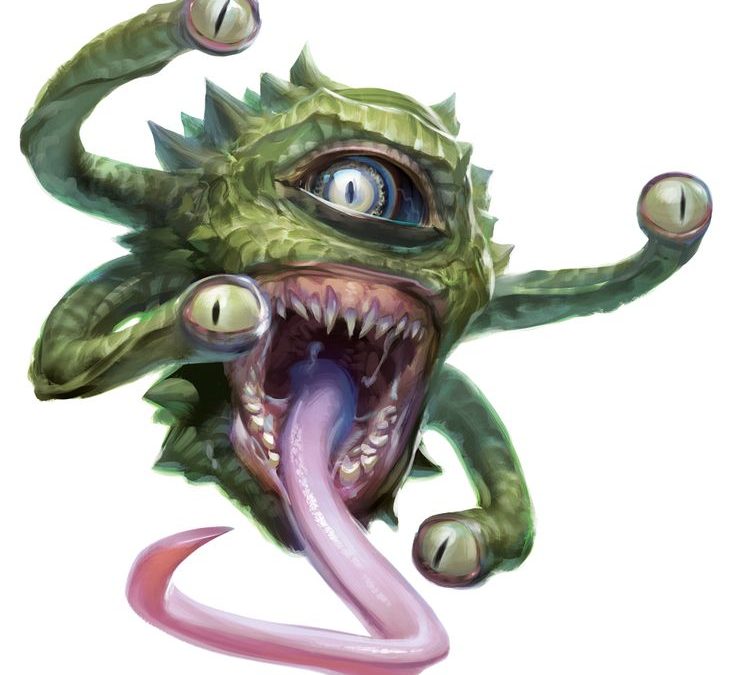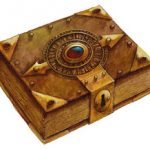There have been a lot of changes since D&D converted from second edition to third, one of the biggest being the way that experience points were given. Originally each monster had an individual XP value and no matter what your level you would gain that much XP from killing it. The theory at the time was that it would scale, but it neglected to factor in problems that came in, for example the infinite XP chicken farm that I’m sure a few of us remember. In 3.0 and 3.5 we now have the challenge rating system which gives a roughly approximate setup for what the party should get in terms of experience points from different encounters and what the rough challenge of each monster is. This system, while superior in many ways to the individual XP design, has a rather bad tendency of being improperly balanced.
There are some examples of grossly under-CRd monsters, the most infamous of them likely being the varied clockwork horrors. There have also been many complaints about the CR of creatures such as Horrid Rats or Runehounds. Beings that tend to make many groups question the validity of the CR system. One issue that often comes up is what constitutes a challenge. The DMG states that it is based off of what an ‘average’ 4 person party is capable of handling per day. The average party is assumed to be a Fighter, a Cleric, a Wizard, and a Rogue all made on 25 point buy. This method is somewhat of an anomaly as many groups have had odd mixings, use classes from various supplements, and also have differing numbers of players.
The first question in this is probably what properly constitutes a challenge. The standard definition is the question of expenditure of party resources, gold, charges, spell slots, and hitpoints. The idea is that there are supposed to be four encounters a day and those encounters will burn through 25% of total party resources roughly. This sounds fine in theory but will often find itself failing to work in practice. There are a slew of stories from DMs who have players either wiped out by something that should have been at or below their set CR, and there are also stories of groups stampeding through things of a much higher CR than they should be able to. The answers given range from the group being poorly prepared, played poorly, the DM not running the encounter properly…the list goes on and on and on.
The first rung of the problem is from what was mentioned earlier, the CR system works on the assumption that the party possesses a Wizard, Fighter, Cleric, and Rogue. These are the base classes and are likely the most versatile, the game assumes that the group is a group of four with one of each of these classes. The CR system may become skewed if something like the rogue, fighter, Wizard, or Cleric is missing or if the group has more or fewer members than the standard planned game is set to. However there are precious few guidelines on how to regulate this, except mentioning that a party lacking a cleric will likely find undead far more challenging and that certain monsters are far more difficult to defeat without the arcane firepower made available by a wizard. Also, a trapped tomb becomes far more difficult to navigate if the party lacks a rogue. With the new supplemental classes the number of options available simply exploded, all of a sudden you could be a Wu Jen, Hexblade, Samurai, Spellthief, Warlock, Shugenja, there were literally dozens of options. Expanding further were the new systems of magic, psionics, the tome of battle, Incarnum, the concepts and capabilities of characters multiplied exponentially. Mixing abilities, feats, skills, classes and prestige classes between these books someone could make truly incredible characters, as well as rather obscene monsters and NPCs.
This leads into the second rung, with all the options available many DMs felt a strong need to either ban these new materials, label them DM only, or allow them in without first making sure they fully understood what the rules for these new things were. I mentioned one of the problems with many ‘core only’ games was that they were really core only for players but DMs would pull from every book under the sun which I found rather unbalancing and also rather unfair to players. The problem became that the CR system got screwy again when a DM or player would misinterpret the rules for something, combine abilities through 15 books, or find some kind of perfect combination that would allow for total unmitigated victory. This isn’t to claim that the supplements are unbalanced or that DMs who don’t allow everything in are tyrants; this is to point out that some problems come from general unfamiliarity with something. A DM might forget that an Incarnate or Crusader bring different options to the table than a Fighter or Wizard do. The abilities aren’t necessarily stronger or weaker in overall comparison but they were different. A DM might forget that a player with a certain feat set could suddenly go from a fire sorcerer to an ice sorcerer and once again bring their arsenal to bear on the pyrohydra. Also, DMs who had more access to rules could create monsters that were likely far above their listed CR due to a combination of abilities or a combo that the DM discovered. The example I’ll use for my own side was when I made a half-troll ogre called Treebreaker, the group was supposed to hunt him down and get rid of him. He was a fighter/barbarian/frenzied beserker, after all of his adjustments his total CR put him at about 12. The party was around level 10-11, optimized characters, and six member of the party. My assumption was that they would take some damage, maybe lose someone, but that Treebreaker would be a worthy challenge. What happened was that Treebreaker wiped out nearly the entire party, most were just negative and managed to stabilize as he moved on to the next one from his initial leap attack into the fray. The feats I had given him and his weaponry made him grotesquely effective against the group, I hadn’t built him specifically to fight the group or anything in that vein, but he was simply tearing through them like tissue paper. The group managed to defeat him after a very long and painful fight, losing the Dervish and almost losing the knight and dragon shaman as well. The group had fairly strong teamwork, had appropriate wealth by level, and were at the very least moderately optimized, and yet this thing slaughtered them.
This next part relates to what I made, I believe that the first problem that the CR system faces has to do with how it is designed. It is a solid set of numbers, it does not waver at all. However one CR 3 monster does not equal another CR3 monster, their position on that level of the challenge rating system has to do with the amount of power they have, the way it works, and the theoretical amount of resources that the party will expend in battling it. However, each monster will damage the party differently and will require a different sort of resource when fighting it. The CR system does not have things in place to work out how to adjust it, and what adjustments would be appropriate, depending on the situation. Is a monster that is fighting in highly favorable terrain a greater challenge, and thus a greater XP reward, than a monster that is fighting the players on terrain that is neutral to both sides? The problem is that I’ve found that as the books go the power creep of monsters becomes rather noticeable. A Runehound can tear a level 3 party to bits if it manages to surprise them simply because of it’s capabilities. For this example I am going to use a standard party of 4, Cleric, Fighter, Rogue, and Wizard. Example: Runehound senses party near territory, runehound moves into range (100ft) and fires away with it’s gluttonous goo shot which sticks a party member, let’s say cleric, to the ground, assuming average rolls for timing the runehound can goo again in 2 rounds. That is surprise round, party rolls for initiative. If the party can see the runehound the chances are better, the fighter shoots his bow, arrow doesn’t seem to deal any damage, runehound has damage reduction 5/silver. Runehound goes and shoots the ranger with it’s acid spit and deals an average of about 15 damage, and in two rounds it can fire again. 15 damage might not look like much, but that can be decent sized chunk of HP for a fighter. Also, at level three the group probably doesn’t have the money to purchase silver weaponry, or the opportunity never presented itself, or they never thought to. The runehound will now be shrugging off most of the damage that they deal, also the runehound possesses fast healing 3 a major protective factor when combined with the damage reduction. The runehound also has about 10 feet of reach in all directions, can attack in any of those squares melee wise, and has combat reflexes and a good dexterity. The rogue hides, hoping to sneak up on it and sneak attack it. The wizard lets fly a scorching ray, 12 damage average, not too shabby at all. Cleric attempts to free themselves, can’t do it, uses cure moderate wounds on the fighter to help restore hitpoints. The fighter very badly wants to switch to his melee weapon and move in to fight since that would be better for him, but the runehound is severely out of charge distance and he doesn’t want to move to fight without aid. The runehound knows exactly where the rogue is by the way, with a blindsense of 500 feet in all directions the rogue is quite visible. The party is very much in trouble. The wizard can try to bring it down with spells but those spells hurt, the runehound might simply decide to withdraw from combat and hunt the group later. Adding in that a runehound has a +20 to survival checks to track targets means that the group could get ambushed again. This monster hardly seems a CR 3, especially if compared to another CR 3 like the Ogre who is far more manageable to fight, has fewer special abilities, and is far more well known. The Runehound may be a CR 3 but it is on the higher end of it, similar to the races that are too strong to go without a level adjustment but not really worth an entire level lost.
The next problem has more to do with what happens if the monsters listed in the monster manuals are modified in any way shape or form. A simple example can be adding classes or templates, sometimes both, to a monstrous opponent. Most people agree that, short of dragons and Tarrasques, the most powerful opponent that a player can face is another classed character of some sort. This opponent can bring out a great deal of variables, their weaknesses aren’t glaringly apparent with a knowledge roll, they can be expected to be roughly as optimized as the group, and they can theoretically use the same sorts of tricks that normal players do. Classes have a tendency of messing with the set CR of a monster, some of it comes from using the elite array, point buy, or rolling to generate the new monsters stats, but also come classes synergize incredibly well with a monstrous NPC and that CR 6 might average to an ECL of 14 for a player depending on the combination. If the monsters are in groups this can get even more complex, a party rarely has a character like a marshal in it but what if the hobgoblin tribe has a pair of martial directing the battle. Or, to remain core, a pair of bards beating war drums chanting the histories of the storied clan. This can throw of the CR system even moreso because their abilities provide power to a large group rather than just one or two, so how much does it affect the challenge rating? Even mixing up the beings in the encounter can alter the challenge rating. Imagine a group of kobolds supported by a runehound as an artillery piece. Or, more believable perhaps, an aboleth using its intelligence to direct its more physically powerful servants, setting them up to support one another and aid each other against its enemies would that affect the overall challenge rating? The final part is this, the NPC the group faces is probably not going to be around forever and doesn’t need to worry about getting his/her/its throat torn out by a random encounter or anything like that. What this means is that the BBEG or general enemy can effectively nova. Throw their strongest stuff into this fight since if they don’t they will likely lose and die. The group will be doing the same but will likely be facing them after having trudged through multiple earlier encounters bleeding them for charges, potions, spell slots, and hp. The enemy faces the encounter fresh, possibly got warning and enough time to buff themselves or have readied actions for when the party kicks down the door. This isn’t a balance issue per se but the certain knowledge that you don’t have to worry about running out unless things go nuts and that your power and versatility are properly built means that you can strike hard and fast and do a lot of damage to the group. The treasure that they have at their disposal is also an issue of note, which is the next rung on the problems that the CR system has.
Treasure is the next area, now you’ll notice most of what I’ve done here is focus on the DMs side with monsters and things like that, there is a reason for that. The player side of it is relatively easier to spot than on the DM side and the fact that the DM can throw the CR system overall for a loop with a few modifications here and there to monsters or other opponents. The treasure problem actually has several areas so I’ll deal with them piece by piece. The first area is a pretty simple spot but oftentimes it is forgotten, the power of ‘needed’ items for a character. A common complaint people have about ‘built at level-X’ characters is that their feats, skills, and gear are all optimized to the character right now whereas the more organic group has some items that aren’t as good of a fit at that time. This problem is usually directly proportional to the level that the character starts at, at level 6 a character will likely be stronger out of the box than an organically made one in the game simply because of equipment differences. Mind, in my games the wealth by level charts are more of a guideline than set in stone and usually the organic characters will have slightly more than the guy who just comes in but that also depends on what they did and how they did it. This problem also exists for NPCs, if the DM makes a BBEG said BBEG as well as minions thereof will likely have optimal equipment to make them effective, the best stuff for what they do that they can have at their level. This again aims the power problem slightly in the favor of the NPC. The secondary problem has more to do with the nova effect that I mentioned earlier. Make an NPC three ways, in one give them only non-charge items, things that give flat bonuses, can be used X/Day or things like that; The second way involves giving them all charge items such as scrolls, potions, wands, rods and staves; The third option involves some combination thereof. The nova effect doesn’t necessarily alter the CR of the opponent but it does alter their treasure reward as each charge, potion, or scroll consumed will decrease the overall haul and increase the power of the person using it, thus giving the players diminishing returns yet again. The equipment available also has something to do with it, the NPCs will probably not use equipment that they are not proficient in, but the party might not be able to use the spiked chains, greatspears, or other exotic items wielded by their foes; The other side of the equation has more to do with the items being unsuitable due to alignment placement or types of gear. At that point the item is either traded, sold, or (if the party has an artificer) drained of XP so the party can make new gear. Another problem is more from a recent trend of Wizards giving the set treasure for monsters in their books. I am against this mostly because it doesn’t show what tables were being used to make it and I don’t like blindly fumbling around, trying to adapt treasure, and also having to wonder if by changing the treasure/gear of the monster that I’m radically adjusting its CR since the treasure was likely factored into it. This is the end of this for the DM side for a while as we are now going into the player realm and how the players, both intentionally and unintentionally, screw up the CR system.
From treasure we go to equipment, this is where the party can get incredibly nasty for the CR system especially with certain tweaks. The first area is likely common ground, equipment creating a planned or unplanned synergy with other abilities leading to an overpowering character. The other areas though are a bit harder and a bit less common and screw with the CR system both ways. The one way that it can happen is through item creation. This isn’t the simple item creation either, the scrolls and such, this goes more into items like weapons, armor, staves, wands, rings, rods, and wondrous items. The first obvious problem comes in if the group focuses heavily on item creation, making custom equipment and because of how much cheaper making items is they can sneak ahead on the power curve so long as the creator maintains XP. This can put the group ahead of the wealth by level charts, so does the DM then award them less XP in combat encounters? If so then the crafter is unfairly penalized as they now take a hit from using XP to craft the items, sinking a majority of their feats into item creation, and now getting less XP for their trouble. It can make challenges easier for a time but depending on the way that it is dealt with it can mess up things for everyone and also make players swear off playing item crafters. The other side of the coin is the nova gear player, they are the fighters who have below average weapons, armor, and/or wondrous items but instead chug potions at the start of each fight and wade in to destroy, the rogues who have a ton of boosting potions, generally speaking most of their money is dumped into one shot items. The first problem that this causes is that you have sudden bursts of power in fights, possibly overshadowing others and again messing with the CR system, but then the other side of it is when you run out of potions suddenly you’re weak and the group has to expend more resources to keep you alive and functioning than they would if you used gear with more staying power. Equipment feeds into two other areas that players can cause trouble with, one is the specialization problem and the other is the class options problem,
Class options are the next area that players can screw up the CR system, this one is somewhat of a tricky area though because of the nature of the problem. In some cases the issue isn’t that a class/prestige class/feat chain/whatever is over or underpowered, the problem is that this variable can have several strange effects on the game. The first issue is how familiar the DM is with this option in terms of what it brings to the table and provides the group. An opponent might fall quickly because the player used a tactic or ability that the DM wasn’t ready for or didn’t realize could work. This might make it seem overpowered but the truth was more that the DM simply didn’t realize that what the player had was capable of doing what it did and thus didn’t factor it in when designing challenges. Also, some classes are simply better at some things than others, in a grinding type of scenario a warlock or binder will make regular casters look less powerful even if the reverse is true simply because that sort of encounter or game style makes those classes far better than they would be normally. The other area dovetails with equipment, imagine that one person of each class at level 10 is captured and stripped of their equipment. The cells are identical, the spontaneous casters, monks, martial adepts, incarnum users, psions, warlocks, binders, Dragonfire wielders, etc. are going to have a better chance of getting out and escaping than the fighters, rangers, paladins, and book based casters because of the loss of their gear crippling them due to their dependence on certain parts of it. A wizard that loses their spellbook is in a lot of trouble, so is a fighter that lost their magical weapons and armor, an incarnum character might not use a whole ton of gear and instead have a small number of buff items or a special weapon, overall not that much to repair or replace, they escape, get some lesser replacements and are good to go, otherwise they may need to bust their way out and try to gather up as much of their equipment as is possible during this lovely trip.
Specialization is another area where the player can screw with the CR system, or at least it will appear that way. Specialization can go many routes and this can become abundantly clear if the entire party is doing it. The example I’ll use in this case is that the players go to the DM before the new campaign starts and say they want to do dragon slayer characters. They want to fight dragons and have that be the main focus of the campaign. The DM agrees, thinking that it would be a fun sort of campaign and dragon slayers are an archetype of fantasy. A side effect of this decision is that the group will be specializing with their characters. Their entire goal in this game is to be the greatest dragon slayers in the world, thus the combat characters get dragonbane weaponry, if someone plays a ranger they have favored enemy: Dragon, they focus their feats and designs for fighting dragons and taking prestige classes like Dragonslayer, Dragonstalker, Hoardstealer and things like that. The casters will focus their spell repertoire on fighting dragons, taking elemental damage spells, things that ignore spell resistance, and debuffs that specifically target dragons to make them weaker or to harm them more than normal spells. The game progresses and the DM gets concerned, the party is fighting dragons and the DM is worried because the party seems to be taking on dragons far more easily than the CR system says that they should. The DM questions if perhaps he is running the dragons incorrectly, or maybe the group has too much gear, or maybe they’re simply far too powerful. The DM makes the decision to alter the CR, give the group less XP for the dragons and alter the treasure horde, give the dragon more gear for itself that only it can use, use more lair wards so the group gets less treasure and less that they can use or sell. This can work but the other side of the coin is that if the group were to face an aboleth, a storm giant, or something like that they might get hurt badly or even wiped out by something of equal or even lesser CR simply because they are so focused on dealing with dragons that they have trouble dealing with something that isn’t one. If this same party runs into a slew of aberrations on their way to fight a deep dragon and the DM sees how much trouble the party is having on things that were supposed to be relatively simple challenges would they then raise the XP rewards to compensate? Specialization now hurts the party, the casters lack the spells that would give them an edge here because most of their focus was fighting dragons, the weapons and other equipment used by party members is suddenly far less powerful and potent because it is now not being used against dragons.
The final problems of the CR system have to deal with areas that are more of a subjective area that have a problem between player and DM, areas that deal with things such as tactics, styles, and preparation. The tactics are the first area in the analysis, the tactics are aimed at certain styles of combat. Tripping is the first one, tripping is an annoyance when the players face it, it can even be a major problem for the whole party if they deal with a massive number of trippers but generally they will be an annoyance for the party rather than a major problem. The tripper if built as a fighter for example can be the ultimate tripper and can be a lot more dangerous as a PC than as an NPC. This is a side note but it is also a fact I have seen that certain races are far more dangerous as NPCs than as PCs and vice versa, at low levels warforged can be something that makes the party shake and shudder but it isn’t really as good as a PC at low levels comparatively. The other issue of style is sundering, I know very few people who play sundering characters simply because sundering is generally very unprofitable to the PCs. Broken weapons sell for basically nothing, that magic item that could have gotten thousands is now junk. Sundering might make a fight somewhat easier but unless that item is frankly murdering the party then the best course is to try to tough it out and take down the person using it, or at the very least disarm them of it. On the DMs side of the screen sundering is a very powerful tool, it can permanently disarm a fighter of a useful weapon, reduce the threat of a rogue, and get rid of the mage slaying weapon that you fear being used against the caster opponent you made. Sundering will hurt the players more than the DM because the DM has an infinite supply of gear, the player does not. The other area that can alter CR in one favor or another is damage reduction. There are currently multiple types, dealing with how the weapon deals damage, universal principles, and the materials the weapon is made from. A fighting character that is a melee type that wants to overcome all forms of damage reduction will have to golf bag weapons, and if they want the weapons to be at least moderately effective and the wealth by level tables are followed strictly they will likely never have a weapon that goes beyond +6 and that total will belong to their main weapon. Damage reduction the players may have will matter less because most of it is either incredibly easy (X/Magic) or impossible (X/-) to overcome and if the group faces forces that know of them they will likely have dealt accordingly. Preparation is another big one, a group prepared for an encounter will have an easier time than one that is not, but that again begs the question of how the CR system imagines combat. Is combat assumed to be on a flat plane with the opponents having clear view of each other within 30-60 feet?
The last aspect is the trickiest one because it can’t really be quantified beyond knowing it when you see it, but the biggest thing that affects the CR is group cohesion and teamwork. One of the biggest complaints made towards classes has to do with how they compare to another class in terms of power, damage, etc, but very little attention is given to how they will affect or contribute to the group as a whole. The biggest thing that people often forget is that the whole is far greater than the sum of its parts. I have seen groups that were composed entirely of one man shows who at best would work parallel get their asses handed to them by mildly optimized cohesive teams simply because the one man shows were not ready, willing, or able to work together while the team was so well organized that if one persons nose twitched they would all sneeze. The game probably assumes some teamwork, but how much does it really expect? In general I see an evolution of group tactics and teamwork, in the beginning it is every man for themselves, next it evolves into parallel combat, they all work in the same direction but they are each on separate tracks, third level is closer to a race all of them are now in the same direction but now they may interact, maybe occasionally aid each other or try to block someone else, the final level is akin to a battalion of tanks, individually they are effective, together they are near unstoppable. In a game that I ran my players attacked a hobgoblin camp, the hobgoblins were well organized and their leader had a powerful and cohesive entourage. The party ended up being all over the place, rather than focusing and trying to support each other they all tried to fight the enemy as individuals and were getting creamed. The sad thing was that all except the leader and two clerics were lower level than them, the clerics were equal level and the leader was 3 levels higher. There were many instances where they could have done well if they had tried working as a group, instead they seemed to all sort of fight like a confused mob and it nearly killed the whole group. Do I increase the CR of the encounter then because they were getting so badly hurt or do I maintain it because they need to learn to work together? Does the cohesiveness of the goblins factor into their CR or not?
I need to explain here that my goal isn’t to destroy the CR system or to say that it’s unworkable, what I mean is that we likely expect far too much of it. The CR system is actually fairly simple and straightforward so long as you literally do not deviate, advance, or in any way alter the monsters, treasure tables, and keep the game completely and totally impartial, keep everyone on 25 point buy, and are sure you can properly simulate the tactics of every creature and properly simulate the proper intelligence and abilities of each type of monster. In other words it’s nearly impossible, the trick is to remember that the CR system is not a straightjacket, it’s a guideline. The problem is still there that certain things will change the CR system, not having a cleric can make every encounter much more difficult but if the group has no fighter but two clerics it might be arguably stronger. The real problem is that the CR system is very simple and precise while the game has grown in complexity and capability.







